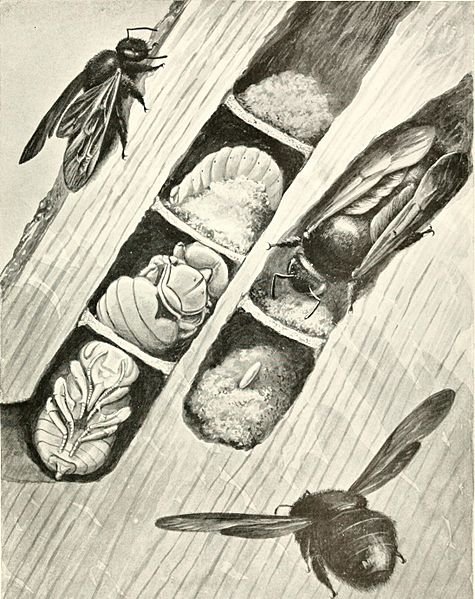Image: Marvels of insect life; a popular account of structure and habit (1916) (14593767158)

Description: The Carpenter Bee. [By Theo. Carreras. There are many species of carpenter bees, all great burly Insects of bluish-black colour. The one represented is found in Europe and known as the violet carpenter. It excavates tunnels in wooden posts, dividing them into chambers, which it provisions, and lays an egg in each. The bees are seen at work, and in the separate cells are masses of pollen with the egg, the grub feeding, and the chrysalis from back and front. The figures are all about twice the size of the Insects. p. 39. Identifier: marvelsofinsectl00steps (find matches) Title: Marvels of insect life ; a popular account of structure and habit Year: 1916 (1910s) Authors: Step, Edward, 1855-1931 Subjects: Insects Animal behavior Publisher: New York : R. M. McBride Contributing Library: Smithsonian Libraries Digitizing Sponsor: Smithsonian Libraries View Book Page: Book Viewer About This Book: Catalog Entry View All Images: All Images From Book Click here to view book online to see this illustration in context in a browseable online version of this book. Text Appearing Before Image: to find a suitable situation in which to spin a cocoon and turn to a chrysalis. It is remarkable that so big a caterpillar may do this with impunity, but it is more than probable that its odour is sufficiently offensive to protect it from attack. Its colour is a pinkish yellow along the sides, which merges into polished dark red along the back. It spends about three years boring tunnels into the heart of sound trees, including poplar, willow, oak, elm, and ash. Before each winter it hollows out a space in its tunnel and spins a comfortable temporary cocoon, in which it lic>sin active during the cold weather. When lull-led it leaves its burrow, and seeks about for light, loose material in which to spin its final cocoon. The chrysalis is mahogany-coloured, an inch and a-half long. There is a line of short, hard spines on the back of each segment, and these enal))c the chrysalis to wriggle half out of its cocoon, so that the moth emerges clear of it. The female is a much 1 Asilid?c. ^ Trypan.is cossus. Text Appearing After Image: The Carpenter Bee. [By Theo. Carreras. There are many species of carpenter bees, all great burly Insects of bluish-black colour. The one represented is found in Europe and known as the violet carpenter. It excavates tunnels in wooden posts, dividing them into chambers, which it provisions, and lays an egg in each. The bees are seen at work, and in the separate cells are masses of pollen with the egg, the grub feeding, and the chrysalis from back and front. The figures are all about twice the size of the Insects. 39 40 Marvels of Insect Life. larger moth than the male, the respective measurements across the outspread wings being — male, two and three-quarter inches; female, three and a-half inches. Apart from the difference in size, the sexes may be distinguished by their antennae; in the female it is merely toothed, but in the male the teeth are long and comb-like, technically pectinated. The mouth-parts are in a very elementary condition, and there is no proboscis. Some remarkable sto Note About Images Please note that these images are extracted from scanned page images that may have been digitally enhanced for readability - coloration and appearance of these illustrations may not perfectly resemble the original work.
Title: Marvels of insect life; a popular account of structure and habit (1916) (14593767158)
Credit: https://www.flickr.com/photos/internetarchivebookimages/14593767158/ Source book page: https://archive.org/stream/marvelsofinsectl00steps/marvelsofinsectl00steps#page/n56/mode/1up
Author: Internet Archive Book Images
Permission: At the time of upload, the image license was automatically confirmed using the Flickr API. For more information see Flickr API detail.
Usage Terms: No known copyright restrictions
License: No restrictions
License Link: https://www.flickr.com/commons/usage/
Attribution Required?: No
Image usage
The following page links to this image:

